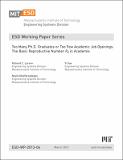| dc.contributor.author | Ghaffarzadegan, Navid | |
| dc.contributor.author | Xue, Yi | |
| dc.contributor.author | Larson, Richard Charles | |
| dc.date.accessioned | 2015-01-29T20:03:23Z | |
| dc.date.available | 2015-01-29T20:03:23Z | |
| dc.date.issued | 2013-09 | |
| dc.date.submitted | 2013-02 | |
| dc.identifier.issn | 10927026 | |
| dc.identifier.issn | 1099-1743 | |
| dc.identifier.uri | http://hdl.handle.net/1721.1/93208 | |
| dc.description.abstract | The academic job market has become increasingly competitive for PhD graduates. In this note, we ask the basic question of ‘Are we producing more PhDs than needed?’ We take a systems approach and offer a ‘birth rate’ perspective: professors graduate PhDs who later become professors themselves, an analogue to how a population grows. We show that the reproduction rate in academia is very high. For example, in engineering, a professor in the US graduates 7.8 new PhDs during his/her whole career on average, and only one of these graduates can replace the professor's position. This implies that in a steady state, only 12.8% of PhD graduates can attain academic positions in the USA. The key insight is that the system in many places is saturated, far beyond capacity to absorb new PhDs in academia at the rates that they are being produced. Based on the analysis, we discuss policy implications. | en_US |
| dc.description.sponsorship | National Institute of General Medical Sciences (U.S.) (Grant 5U01GM094141-02) | en_US |
| dc.language.iso | en_US | |
| dc.publisher | Wiley Blackwell | en_US |
| dc.relation.isversionof | http://dx.doi.org/10.1002/sres.2210 | en_US |
| dc.rights | Creative Commons Attribution-Noncommercial-Share Alike | en_US |
| dc.rights.uri | http://creativecommons.org/licenses/by-nc-sa/4.0/ | en_US |
| dc.source | MIT web domain | en_US |
| dc.title | Too Many PhD Graduates or Too Few Academic Job Openings: The Basic Reproductive Number R[subscript 0] in Academia | en_US |
| dc.type | Article | en_US |
| dc.identifier.citation | Larson, Richard C., Navid Ghaffarzadegan, and Yi Xue. “ Too Many PhD Graduates or Too Few Academic Job Openings: The Basic Reproductive Number R[subscript 0] in Academia .” Systems Research and Behavioral Science 31, no. 6 (September 9, 2013): 745–750. | en_US |
| dc.contributor.department | Massachusetts Institute of Technology. Department of Mechanical Engineering | en_US |
| dc.contributor.department | Massachusetts Institute of Technology. Engineering Systems Division | en_US |
| dc.contributor.department | MIT Sociotechnical Systems Research Center | en_US |
| dc.contributor.mitauthor | Ghaffarzadegan, Navid | en_US |
| dc.contributor.mitauthor | Larson, Richard Charles | en_US |
| dc.contributor.mitauthor | Xue, Yi | en_US |
| dc.relation.journal | Systems Research and Behavioral Science | en_US |
| dc.eprint.version | Author's final manuscript | en_US |
| dc.type.uri | http://purl.org/eprint/type/JournalArticle | en_US |
| eprint.status | http://purl.org/eprint/status/PeerReviewed | en_US |
| dspace.orderedauthors | Larson, Richard C.; Ghaffarzadegan, Navid; Xue, Yi | en_US |
| dc.identifier.orcid | https://orcid.org/0000-0003-3797-3917 | |
| dc.identifier.orcid | https://orcid.org/0000-0003-2776-4900 | |
| mit.license | OPEN_ACCESS_POLICY | en_US |
| mit.metadata.status | Complete | |
